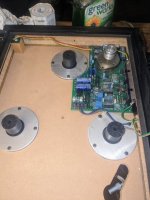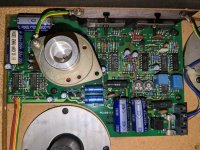I've been experimenting and I thing R50/R51 needs to be there since it (if I understand correctly) controls the switching between high and low voltage drive at U6 (pin10-12) and U7 (pin 6-9). With other values the drive becomes unstable, since switching occurs intermittently.If you alter the values of R50 (33.33 rpm) and/or R51 (45 rpm), the 'motor run' voltage will change.
If you remove R50 and/or R51, the 'motor run' voltage will always be maximum.
View attachment 1156344
Good Luck experimenting...!
To change drive voltage it must include both U3 and/or U4 amplification, as I see it. This would require more calculations to switch components, I believe.
I finally ended up using the old motor which "works" with 25 VAC during operation. I managed to switch the pulley to the LP12 pulley so now it does not wobble anymore.
I still have one error though, and I don't get the 87V start-up voltage and the current sensing during operation. So I do a manual start by hand.
I have 12.6V on SD but it does not drop down upon start. The only ICs I have not changed are the LM324 U5 and U3. Perhaps the first pair U5 amps have blown? I still not certain what it is that makes the 87 to 25 VAC drop, but this is the only amps connected to the motor ground.
I still have one error though, and I don't get the 87V start-up voltage and the current sensing during operation. So I do a manual start by hand.
I have 12.6V on SD but it does not drop down upon start. The only ICs I have not changed are the LM324 U5 and U3. Perhaps the first pair U5 amps have blown? I still not certain what it is that makes the 87 to 25 VAC drop, but this is the only amps connected to the motor ground.
I have an Axis from very early - 1988, maybe? Basik Plus was the standard arm. It is still running fine, but I am worried. I am trying to figure out how to open it up? There are not many pictures in this thread. I am a visual person.
How long after unplugging it is there high voltages present?
Okay - dumb question - here's a video showing the initial disassembly:
It has a different ribbon cable - the switch is mounted on the plinth, so is not detachable. Caps look good - but obviously they are 35+ years old.
How long after unplugging it is there high voltages present?
Okay - dumb question - here's a video showing the initial disassembly:
It has a different ribbon cable - the switch is mounted on the plinth, so is not detachable. Caps look good - but obviously they are 35+ years old.
Attachments
Last edited:
If the TT works as it should, nothing needs to be changed. Just leave it. You can
1) look at the motor pulley when running. Is it smooth or does it wobble? Mine did and I finally made a change of the pulley, but it is hard if you don't have a puller. And expensive as I bought an LP12 motor and used that pulley.
2) change belt if it is old (yes it will actually affect speed!)
3) clean pulley, belt and rim of platter drive. The pulley and platter should SHINE.
4) change oil if very old
5) adjust speed with a test record (it is a bit tricky, but I put the TT on two chairs, having my phone on spectrum detection while playing 3150 Hz, and lying on the floor under the TT. Then setting the trim pot closest to the motor from under the TT as close to 3150 Hz as possible. Switching to 45 RPM, setting the other pot to 4252 Hz.
All those things would probably be better if the drive works as it should. (You could measure the drive at the motor IF YOU FEEL SAFE doing so. Around 87 volts at start-up, and 25 volt at run state.)
1) look at the motor pulley when running. Is it smooth or does it wobble? Mine did and I finally made a change of the pulley, but it is hard if you don't have a puller. And expensive as I bought an LP12 motor and used that pulley.
2) change belt if it is old (yes it will actually affect speed!)
3) clean pulley, belt and rim of platter drive. The pulley and platter should SHINE.
4) change oil if very old
5) adjust speed with a test record (it is a bit tricky, but I put the TT on two chairs, having my phone on spectrum detection while playing 3150 Hz, and lying on the floor under the TT. Then setting the trim pot closest to the motor from under the TT as close to 3150 Hz as possible. Switching to 45 RPM, setting the other pot to 4252 Hz.
All those things would probably be better if the drive works as it should. (You could measure the drive at the motor IF YOU FEEL SAFE doing so. Around 87 volts at start-up, and 25 volt at run state.)
Thanks Thomas - I will clean the motor pulley. That's great advice. I checked the RPM with the phone app, and it is quite good - just a tiny bit slower than 33RPM. My friend's Axis that he got a little while later than I did (he had an Akito arm, I think?) has long ago failed. And he now has a Rega (Planar 2 or 3?).
The belt is original - so I will ask about getting a replacement. And about new oil, too.
If all goes south with this Axis - I will be considering the U-Turn Orbit Theory, for sure.
The belt is original - so I will ask about getting a replacement. And about new oil, too.
If all goes south with this Axis - I will be considering the U-Turn Orbit Theory, for sure.
Last edited:
Hi Thomas - I don't think he still has his Axis. He is not a DIY'er and the repair at the shop where we both bought ours was more than the Rega, I think? It has been a number of years.
What is the best third party belt? And what about oil - it is just something we can get? I use oil for my slot cars.
What is the best third party belt? And what about oil - it is just something we can get? I use oil for my slot cars.
Belt: I bought a third party but it was thinner. The original a bit thicker. I have changed a few times during 30 years and when comparing the old and new original, the original was both a bit stretched and showed polished surface. Speed changed after replacement. If third pary belts are used I suggest to bring the old to compare with at store.
Oil: there is a special black oil from Linn that is recommended. Otherwise I think it should be a thin oil of some kind. I don’t recall the Linn oil is expensive. You can also check the spin time of the platter. Remove the belt and start spinning by hand. It should spin for quite some time. Another way is to watch the red diode during play. It dims down a bit at 25V and should be rather constant. If it shines up often it might be too much friction.
Oil: there is a special black oil from Linn that is recommended. Otherwise I think it should be a thin oil of some kind. I don’t recall the Linn oil is expensive. You can also check the spin time of the platter. Remove the belt and start spinning by hand. It should spin for quite some time. Another way is to watch the red diode during play. It dims down a bit at 25V and should be rather constant. If it shines up often it might be too much friction.
- Home
- Source & Line
- Analogue Source
- Repairing Linn Axis Motor Drive Amplifier

